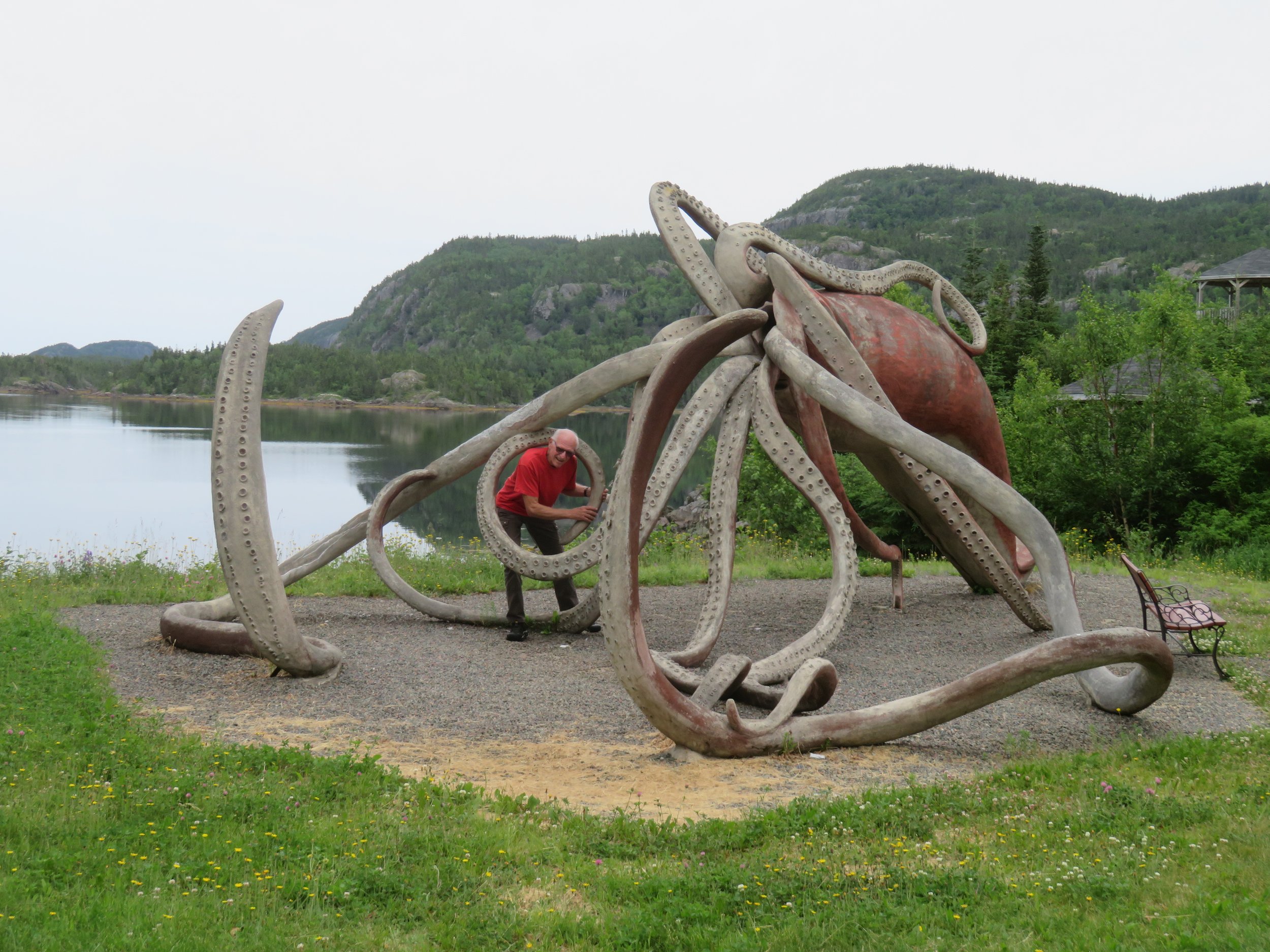An Airport, a Giant Squid and a Sea Serpent
/Sounds odd to want to visit an airport, but Gander International Airport (YQX) was on our ‘to-see’ list. It’s called the Crossroads of the World and for many years it was.
A 1935 agreement between Canada, the UK, Ireland and Newfoundland (Newfoundland didn’t become part of Canada until 1949), moved to establish a military and commercial air service across the Atlantic. It was considered a major risk since in 1935, Trans-Atlantic air travel didn’t even exist. In January 1938, Captain Douglas Fraser landed his single-engine biplane on what was then the world’s largest airport… Newfoundland Airport.
During WWII and the Cold Wreck, Gander was a strategic military location. Throughout the 1950s and 1960s, nearly every Transatlantic flight stopped at Gander to refuel. During its heyday, locals would visit the airport for entertainment to check out the passengers. Celebrities, politicians and world leaders passed through Gander.
The most notable thing to us about Gander, however, was its response to stranded passengers on 9-11-2001. When all of Northern American airspace was closed to commercial flights after the terrorist attacks in the USA, 34 commercial aircraft carrying 6600 passengers and crew along with 4 military aircraft were diverted to Gander. The town population increased by 70% in a matter of hours. The stranded folks hailed from 95 different countries, all with their own languages, cultures, customs and religions. Passengers did not have access to their luggage, only carry-ons were allowed.
Over the course of five days, Gander and its neighboring communities housed, fed and cared for 6600+ ‘Plane People’ or ‘Come From Aways’ (as non-islanders are called), in schools, churches, halls and private residences. The local SPCA also cared for 17 dogs and cats and two chimps. What a gargantuan task and what a remarkable show of hospitality, generosity and human compassion.
A piece of I-beam from the World trade Center was given to Gander in recognition of their efforts.
We walked through the International Lounge and checked out the artwork as well as the historical exhibit on the second floor. The place sends out good vibes!
Gander Airport International Lounge
After the airport, we headed east then north to find the “Home of the Giant Squid since 1878”. It was late afternoon when we left Gander, so when we arrived in the little coastal town of Botwood, we found a great spot on the shores of the Bay of Exploits to overnight. When we awoke in the morning, the water on the bay was like glass. Gulls and yellowlegs sat on the nearby rocks. Loons called and dabbled and called again.
As we were leaving town, we happened to notice a very interesting mural on the side of a building. Two local women were walking by and I commented out the van window, how awesome the mural was. They told us that there were several murals in town illustrating its history and that the local gas station had a brochure describing each mural and its location. That’s all it took. We acquired a brochure and began a scavenger hunt of Botwood’s murals. Take a look at a few of the murals we found. Just click on the thumbnails to enlarge the photo to see the detail.
When we finally coaxed ourselves out of Botwood, we continued all the way north up Route 350 to Leading Tickle at the land’s end, thinking we’d find the Giant Squid there. A ‘tickle’, by the way, is Newfoundland verbiage for a short narrow inlet or strait. We didn’t find the Giant Squid, but we did find the Oceanside Nature Trail for a moderately strenuous trek through the forest and along the coast. The path varied from rocky and muddy to extensive sections of sturdy boardwalk and steep stairs.
We stopped at the historic Jack Ward General Store for a look around at the local crafts and the small community museum upstairs. It was here we learned that the Giant Squid wasn’t in Leading Tickles at all, but rather in Glover’s Harbour not far away.
We found Glover’s Harbour without delay and fortunately, the Giant Squid Interpretive Center was open.
There was much to learn about giant squids and the 1878 giant that went aground at low tide on a nearby shore. David will enlighten you about giant squids in an upcoming blog. I was more interested in taking photos of the Giant Squid that sat in the center’s backyard.
It was still fairly early in the day when we retraced our route back to the TransCanada Highway and took a detour up to Robert’s Arm and Pilley’s Island. The highlight of the trip was a very photogenic sea monster that welcomed us to the town. Known to locals as Cressie, this snake-like creature lives in Crescent Lake, Notre Dame Bay and was first spotted in the 1950s and is still spotted quite frequently today. Cressie has been described as 20-40 feet long, brown and some think she might perhaps be a giant eel. We didn’t see Cressie, but we enjoyed riding her statue.
Time is flying by. We’ve seen so much and there’s still so much to see, but time is running out. That ferry reservation date is fast approaching and we’ll soon begin the drive south to Port-aux-Basques and ferry terminal. Before we do, there’s still a bit to see. Join us next time as we explore the Port-au-Port Peninsula and Boutte du Cap Park.
Here’s a map of our current Newfoundland wanderings.
























